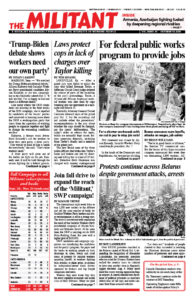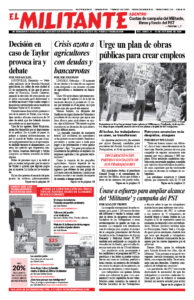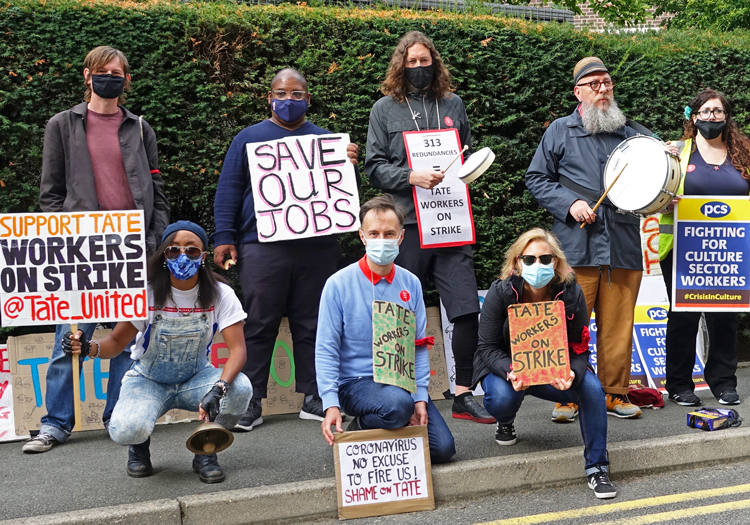MANCHESTER, England — Announcing plans he called a “jobs protection and wages subsidy scheme,” Sept. 24, U.K. Chancellor Rishi Sunak laid out a program that will actually allow bosses to continue dumping the burden of a deepening economic and social crisis onto the backs of working people.
He brought to an end a special government program under which 9.5 million workers, just below a third of the entire working population, have been furloughed since the spread of coronavirus led to government lockdowns. They received only 80% of their wages since April.
Sunak derisively declared he was ending “zombie jobs,” ones he claimed wouldn’t exist without the furlough program, in effect leaving millions of workers to fend for themselves. Many will join the 2.7 million workers claiming unemployment benefits since the pandemic began. Among the hardest hit have been airline and aviation industry workers and those working in restaurants and bars. The official 4.1% unemployed rate doesn’t take into account this new wave of workers chucked onto the streets.
“It’s bad already even before these moves,” Natalie Fox told Communist League campaigners as she bought a subscription to the Militant in Altrincham, Greater Manchester. “My nephew just got made redundant along with 400 others from the Cartwright vehicle factory. I got laid off two weeks before my maternity leave ended along with my furloughed workmates at the shoe repair chain Timpson.”
“We need to mobilize millions in a union movement to fight to shorten the workweek but with no loss of take-home pay and to fight for a massive program of public works to provide jobs,” replied Communist League campaigner Anne Howie.
Sunak’s decision allows bosses to decide whether or not they want to take back furloughed workers and employ them for the next six months, working for at least a third of the hours that they put in before the pandemic. These workers would then effectively have the rest of their take-home pay slashed. The lost wages would only be partly be made up, with the bosses covering a third of the pay cut, and the government another third. The final third the worker would have to do without.
“These measures are just options for companies. We are at their mercy,” meat worker Matthew O’Neill at Pilgrim’s Pride in Dukinfield near Manchester told co-worker Hugo Wils.
When workers at the plant were sick, “we only got paid statutory sick pay of 90 pounds a week [$116] instead of the 80% furlough pay.” Like many others, workers at Pilgrim’s have had no pay rise this year. “That’s why we need to rely on our strength and capacities to stand up to the bosses and to fight to improve our wages and conditions,” said Wils, a Communist League member.
Gov’t moves hit the self-employed
The government has also slashed the amount self-employed workers can claim as benefits, from 80% of average net income prior to the pandemic, to 20%.
“I tried to go back to work,” Manchester taxi driver Diyar Kamil told the Militant, “but it was hopeless. Few people are traveling to the airport and there are no big sport or music events. The competition among cabbies is massive.”
Kamil had been on a parallel scheme to the furlough setup along with 2.6 million other self-employed workers.
Hundreds of cab drivers in Manchester demonstrated against a further attack on their livelihoods Aug. 26, protesting a new tax on drivers imposed by the City Council in the name of protecting the environment.
“They think we are the problem,” Kamil said.
“Yes,” this worker-correspondent replied, “and the action was an important step towards overcoming the competition that cab drivers face.”
In Tottenham, north London, the combined figure for unemployed and furloughed workers is the highest in the country.
“It’s going to take action by working people to change the conditions we’re facing,” Tony Edwards, a roadside vehicle recovery driver who lives in the area, told CL campaigner Dag Tirsén.
Tirsén had told him about the recent strike action to stop job cuts by workers at the Tate art galleries in London. “When the bosses move to cut jobs, the unions’ response should be to organize workers to fight for a shorter workweek with no cut in take-home pay,” he said.
Prime Minister Boris Johnson’s ruling Conservative Party is keen to retain the electoral backing it gained in the last election in many largely working-class areas where many people had previously voted for the Labour Party for decades. Sunak presented his measures only after meeting and winning the blessing of both Trades Union Congress leader Frances O’Grady and Confederation of British Industry director Carolyn Julia Fairbairn.
Labour Party spokesperson Anneliese Dodds said the government’s decision to replace the furlough scheme was a “relief,” but complained that the delay in doing so had negatively affected what she called “business confidence” — that is, the bosses’ willingness to invest in order to profit from our exploitation.


